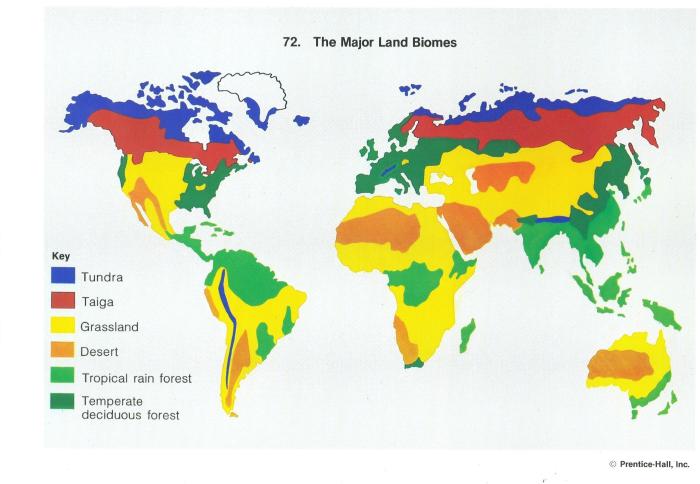Map of north america biomes – Embark on a captivating journey through the diverse biomes of North America, where nature’s intricate tapestry unfolds before our eyes. From towering forests to arid deserts and sprawling grasslands, this map unveils the ecological wonders that define this vast and vibrant continent.
Our exploration begins with a comprehensive overview of the continent’s biome distribution, guided by an informative map that pinpoints the major biomes and their geographical locations.
North American Biome Distribution
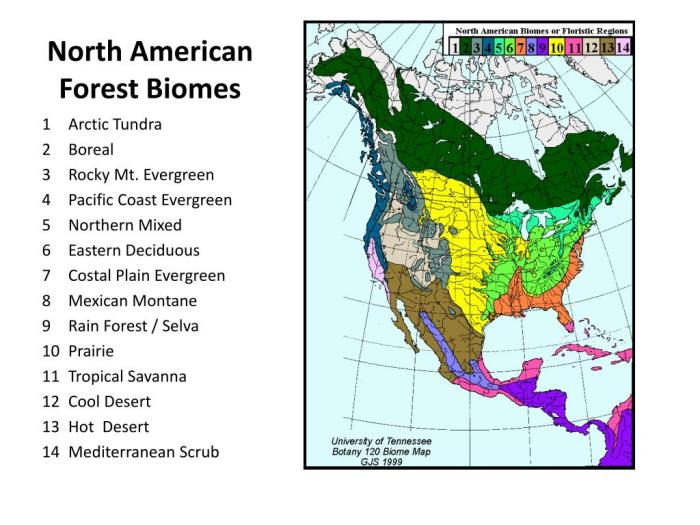
The distribution of biomes across North America is primarily influenced by factors such as climate, topography, and soil conditions. The continent exhibits a wide range of biomes, from the cold and icy tundra in the north to the lush rainforests in the south.
The major biomes of North America include:
Boreal Forest
- Characterized by coniferous trees, such as spruce, fir, and pine.
- Extends across northern Canada and Alaska, and into the northern United States.
Temperate Forest, Map of north america biomes
- Dominated by broadleaf deciduous trees, such as oak, maple, and birch.
- Found in the eastern and central United States, as well as parts of southern Canada.
Grassland
- Characterized by vast, open areas covered in grasses and wildflowers.
- Located in the central and western United States, as well as parts of southern Canada.
Desert
- Arid regions with sparse vegetation, such as cacti and shrubs.
- Found in the southwestern United States and parts of Mexico.
Tundra
- Characterized by low-growing vegetation, such as mosses and lichens.
- Located in the far north of Canada and Alaska.
Biome Characteristics
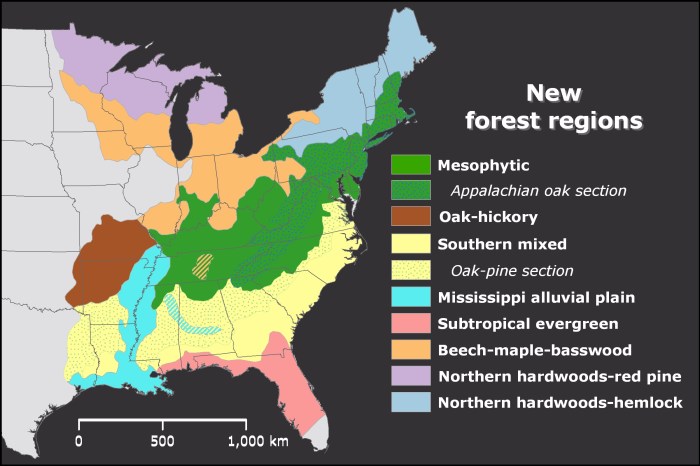
North America’s diverse biomes are shaped by a complex interplay of climate, geography, and ecological processes. Each biome exhibits unique characteristics that define its vegetation, wildlife, and overall ecological dynamics.
From the frigid tundra to the lush rainforests, North America’s biomes showcase a vast array of habitats and species.
If you’re interested in the map of North America biomes, you might also find the National Provider Identifier (NPI) number of Dr. Joseph Smith informative. This unique identification number is assigned to healthcare providers in the United States and can be used to verify their credentials.
You can find more information about Dr. Smith’s NPI number here . Once you have his NPI number, you can continue exploring the fascinating map of North America biomes.
Tundra
The tundra biome occupies the northernmost regions of North America, characterized by a cold, dry climate with permafrost. Vegetation is sparse, consisting primarily of mosses, lichens, and low-growing shrubs. Wildlife includes caribou, polar bears, and Arctic foxes.
Boreal Forest
The boreal forest, also known as the taiga, stretches across the northern regions of North America. It features a cold, humid climate with long, cold winters and short, warm summers. Coniferous trees, such as spruce, fir, and pine, dominate the landscape, providing habitat for moose, wolves, and lynx.
Temperate Forest, Map of north america biomes
Temperate forests occur in the eastern and western regions of North America. They experience a moderate climate with distinct seasons. Deciduous trees, such as oak, maple, and beech, are prevalent in these forests, shedding their leaves in the fall. Wildlife includes deer, black bears, and various bird species.
Grassland
Grasslands, including prairies and savannas, cover vast areas of central North America. They are characterized by a temperate climate with hot summers and cold winters. Grasses and wildflowers dominate the vegetation, providing habitat for bison, pronghorn, and prairie dogs.
Desert
Deserts occur in the southwestern United States and northern Mexico. They are defined by an arid climate with extremely high temperatures and low precipitation. Vegetation is sparse, often consisting of cacti, succulents, and shrubs. Wildlife includes desert bighorn sheep, coyotes, and rattlesnakes.
Mediterranean
The Mediterranean biome is found in California and parts of Chile. It features a mild, wet winter and a hot, dry summer. Vegetation is characterized by evergreen trees and shrubs, such as oaks and chaparral. Wildlife includes deer, mountain lions, and various bird species.
Tropical Rainforest
Tropical rainforests occur in the southeastern United States, Central America, and parts of Mexico. They experience a warm, humid climate with abundant rainfall throughout the year. Lush vegetation, including tall trees, vines, and epiphytes, creates a dense canopy. Wildlife is incredibly diverse, including monkeys, jaguars, and a wide variety of birds.
Biome Interactions
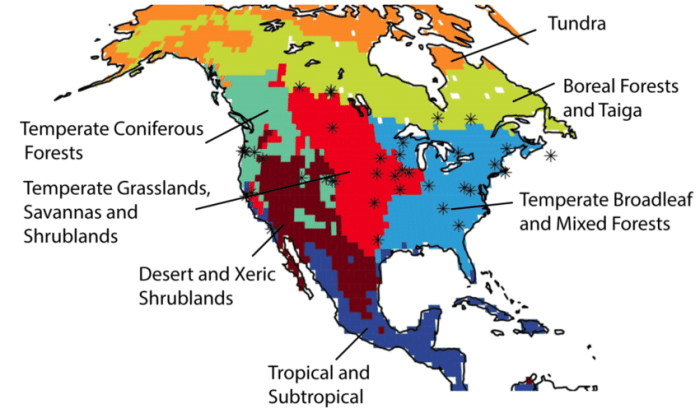
Biomes are not isolated entities but rather interact and influence one another in various ways. These interactions can range from the exchange of species and nutrients to the regulation of climate and ecosystem services. Understanding these interactions is crucial for comprehending the dynamics and functioning of Earth’s ecosystems.One
of the most fundamental interactions between biomes is the transition from one biome to another. These transitions are often gradual, with one biome gradually blending into the next. The factors that influence these transitions include climate, topography, soil conditions, and the availability of water.
For example, as you move from a temperate forest to a grassland, the amount of rainfall decreases, the temperature becomes more extreme, and the soil becomes less fertile. These changes gradually favor the growth of grasses over trees, resulting in the transition from forest to grassland.Another
important interaction between biomes is the exchange of species and nutrients. Species often move between biomes in search of food, mates, or new habitats. For example, birds may migrate from a temperate forest to a tropical rainforest during the winter months to escape the cold weather.
This movement of species can help to maintain genetic diversity and ensure the survival of populations. Additionally, nutrients can be transported between biomes by wind, water, or animals. For example, dust from the Sahara Desert can be carried across the Atlantic Ocean and deposited in the Amazon rainforest, providing essential nutrients for plant growth.Finally,
biomes can also interact through the regulation of climate and ecosystem services. For example, forests play a crucial role in regulating the Earth’s climate by absorbing carbon dioxide and releasing oxygen. They also help to regulate water flow and provide habitat for a variety of species.
By understanding these interactions, we can better manage our ecosystems and ensure their long-term sustainability.
Human Impacts on Biomes
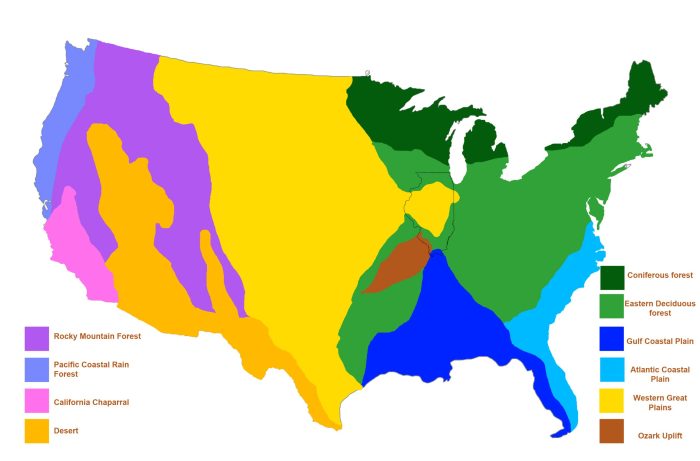
Human activities have profoundly shaped the distribution and characteristics of North American biomes. These impacts range from positive, such as conservation efforts, to negative, such as deforestation and pollution.
Positive Impacts
- Conservation:Protected areas, such as national parks and wildlife refuges, preserve habitats and species diversity.
- Restoration:Reforestation and wetland restoration projects aim to restore degraded biomes and enhance biodiversity.
Negative Impacts
- Deforestation:Clearing forests for agriculture, logging, and development fragments and reduces the size of forest biomes.
- Pollution:Air and water pollution from industrial activities, agriculture, and transportation can harm plants and animals, leading to ecosystem disruption.
- Invasive species:Introduced non-native species can outcompete native species and alter ecosystem dynamics.
- Climate change:Rising temperatures and altered precipitation patterns are shifting the boundaries of biomes and affecting species distribution.
Conservation and Management: Map Of North America Biomes
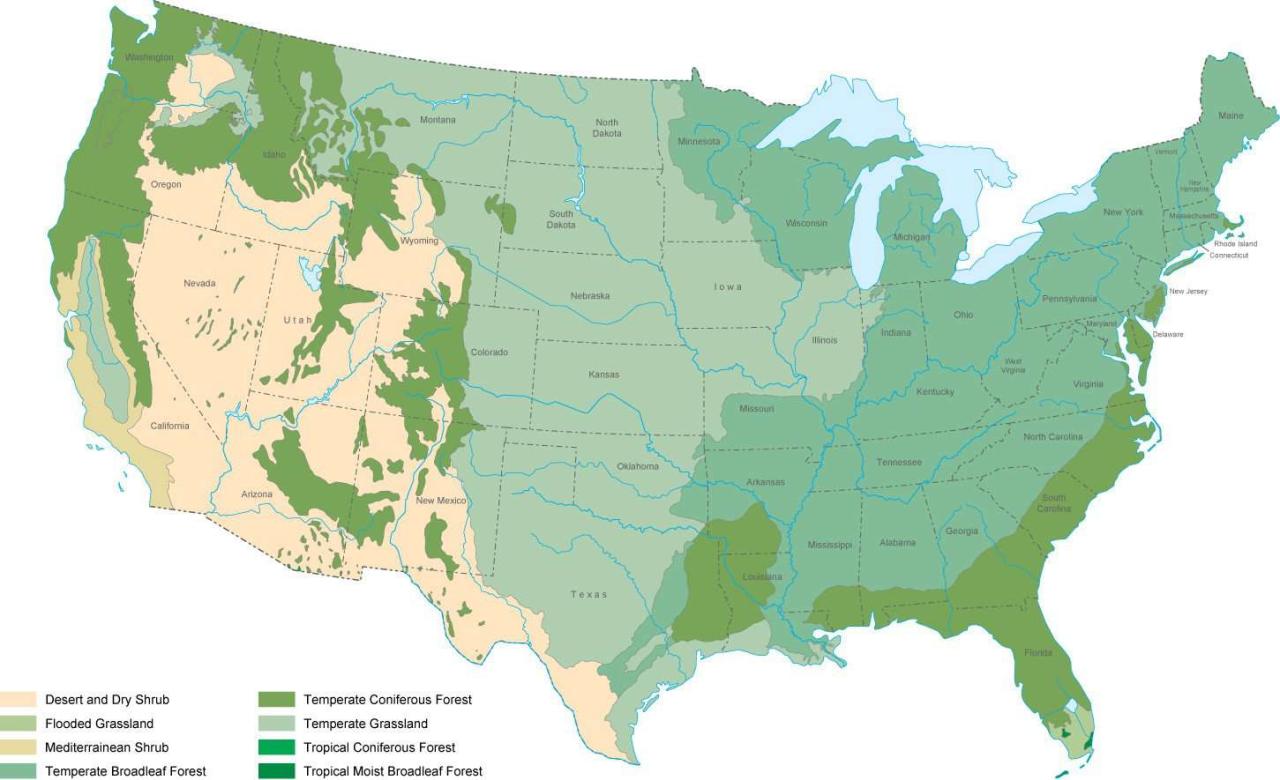
Conserving and managing North American biomes is crucial for their ecological integrity and the services they provide to humans. Biomes harbor unique species, ecosystems, and natural resources, making their preservation essential for biodiversity and the health of the planet.
Current Conservation Efforts
Efforts to conserve North American biomes include:
- Establishment of protected areas such as national parks, wildlife refuges, and wilderness areas.
- Habitat restoration and management programs to restore degraded ecosystems and improve wildlife populations.
- Species conservation measures to protect endangered and threatened species and prevent their extinction.
- Education and outreach initiatives to raise awareness about the importance of biome conservation.
Challenges
Conservation efforts face challenges such as:
- Climate change, which is altering biomes and threatening species and ecosystems.
- Habitat loss due to urban development, agriculture, and resource extraction.
- Invasive species, which compete with native species for resources and alter ecosystems.
- Pollution and other human activities that degrade air, water, and soil quality.
Overcoming these challenges requires collaborative efforts among government agencies, conservation organizations, and the public. By working together, we can protect and preserve the invaluable biomes of North America for future generations.
FAQ
What is the largest biome in North America?
The largest biome in North America is the temperate broadleaf and mixed forest, covering vast areas of eastern and central North America.
How do biomes transition into one another?
Biomes transition into one another along environmental gradients, such as changes in temperature, precipitation, and soil conditions. These transitions create ecotones, which are areas of gradual change between biomes.
What are the major threats to North American biomes?
Major threats to North American biomes include habitat loss, fragmentation, pollution, climate change, and invasive species.
